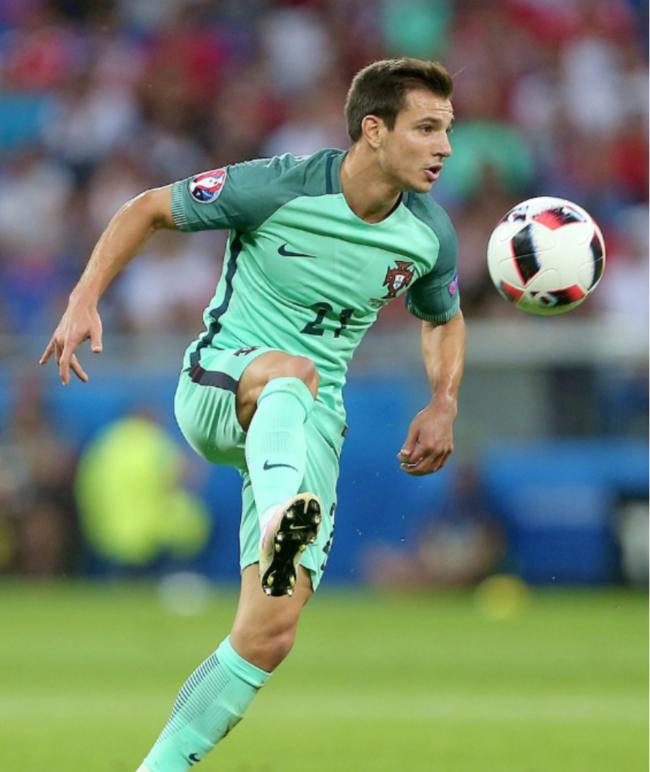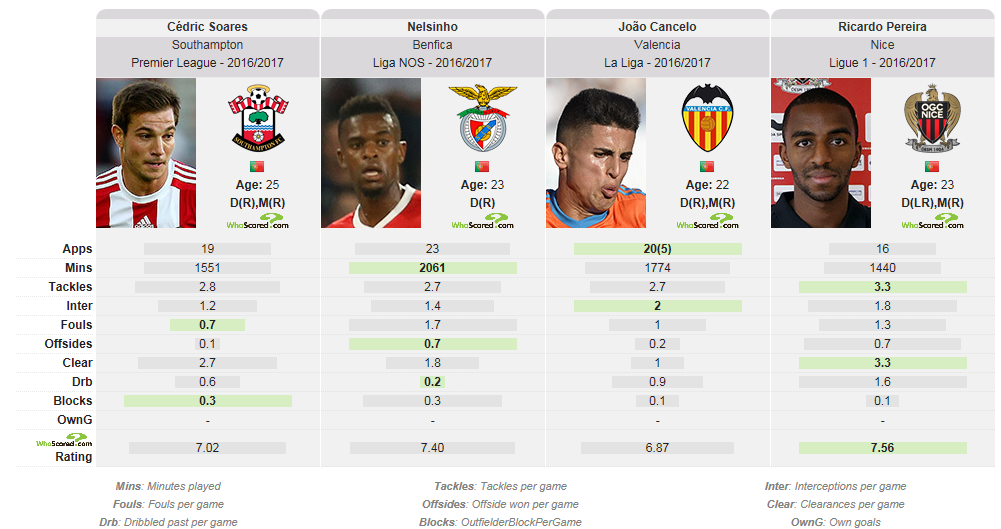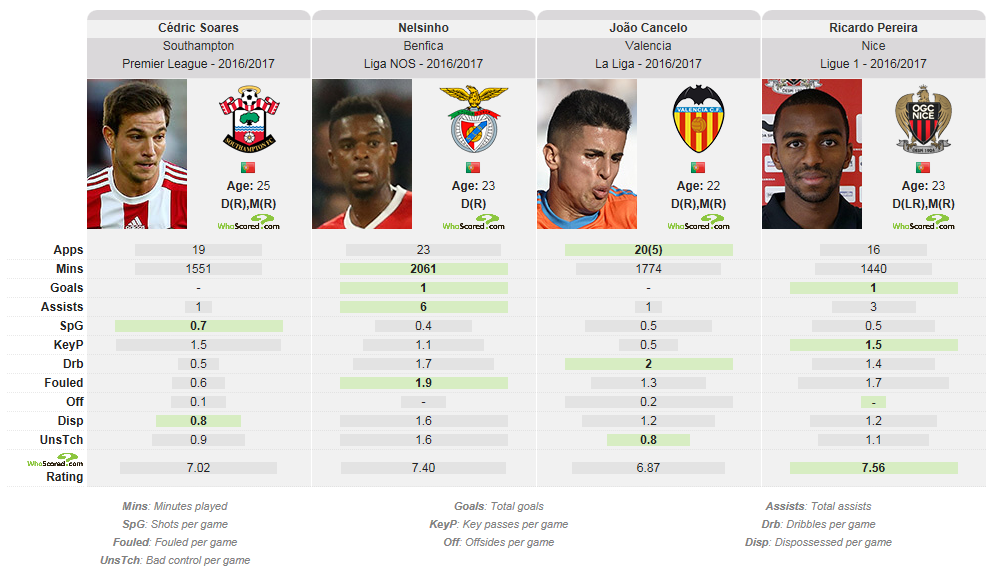 Why Cédric should be Portugal’s starting right-back
Why Cédric should be Portugal’s starting right-back
It should have been a goal. He had already shown exceptional awareness to pick-pocket Marcos Rojo, and good strength to shrug off the Argentine’s last-ditch challenge. But even when Cédric’s lovely outside-of-the-right-boot cross for Gabbiadini’s goal was incorrectly ruled out for offside in the 11th minute of the EFL Cup final, I knew I had witnessed something special about a player that is so often understated.
Just 5’7” tall, the 25 yr old German-born fullback has never been one to cover the front pages of football periodicals with gaudy statistics. But Cédric’s stout build and collective guile has thus far served him well since transitioning to the English Premier League two summers ago from Sporting.
With strength, composure under duress, and the kind of positional discipline that frustrates attackers looking to exploit an extra yard of space, Cédric embodies not just the pragmatic elements of the modern fullback, but also those most essential to the Seleção.
Even so, Cédric faces stern competition from a trio of young fullbacks emerging from the richly talented U21 squad that has Portugal fans asking previously unutterable questions such as, “will we actually win the World Cup?” All hyperbole and euphoric imagination aside, 2018 looms large for Portugal.
For those that have read my work before, I do make a sincere effort to rationally substantiate my preferences for a certain player or tactic, and this article will be no different. In this case, I do not only wish to know which right-back scores or assists the most goals, completes the most successful dribbles, and makes the most interceptions. These do matter of course, but I care much more about which right-back would best thrive within Fernando Santos’ 4-4-2 in a diversity of contexts. But first it is prudent to make a rudimentary statistical comparison to highlight any obvious discrepancies.

What becomes clear after looking at these league play-only (excluding European/domestic cup matches) defensive statistics is that no player dominates across the board. Ricardo Pereira makes the most tackles and clearances per match, Cancelo the most interceptions, Cédric concedes the least amount of fouls, etc.
The offensive metrics (below) also reveal few discrepancies although there are some important clues about each of their individual styles. For example, Cédric is tidy in possession, Nelsinho creates goals and wins free kicks for his side, and Cancelo enjoys dribbling past his marker with good close control of the ball. These statistical measurements absolutely confirm each player’s unique interpretation of the right-back position for their clubs.
But to play a certain role well for one’s club does not mean that role would translate directly to the Seleção. Good club players occasionally fail to adapt to the style of their national team or, in some cases, average club players perform well above expectations for their country. My point is that choosing a right-back, or any player for that matter, based solely on club form is naïve. The playing environment, squad tactics, chemistry, responsibilities, quality of opposition, and many other factors are all very different from club football. This is why only the most elite players ever successfully achieve the standard of competitive performance required at the international level.

For the sake of brevity, I'll evaluate the position of right-back with respect to three decision-making elements.
Defensive stability
While Benfica and Valencia might be more dependent on the marauding runs of Nelsinho and João Cancelo respectively, Portugal are lavished with skillful playmakers. With the likes of Bernardo Silva, João Mário, and Ricardo Quaresma providing Ronaldo and André Silva, who already have 45 goals between them this season, the benefit of a marauding fullback is dampened somewhat. Instead, with so many attack-minded players already on the pitch, there is a genuine risk that a forward-thinking fullback might get caught out on the counterattack. We all saw how brilliant Cancelo was against the Faroe Islands, but does anyone honestly think his adventurous forays would be as effective against Germany, Spain, or France? Me neither.
I want to be clear, I do not wish to disparage fullbacks who influence matches with attacking vigor, far from it. I am only suggesting that this style of play might destabilize Portugal against the elite competition they will face in major tournaments. Recall the Euro 2016 knockout round match against Croatia. What mattered more: for our right-back to contribute offensively, or that he shut down a dangerous player like Ivan Perisic? I vote the latter, which is precisely what Cédric did. I would maintain that in tournament play our fullbacks will be counted on to deny our opponents’ creative outlets on the wing more often than to play a killer final ball.
There was another movement during the EFL Cup final that will help put this discussion into its proper context. With Southampton in possession, play evolved down the right wing and the ball found its way to Cédric who had to return toward the ball with his back to goal. Having drawn the attention of several defenders, Cédric turned inside his immediate marker and slid a simple pass into space beyond the defense allowing his supporting winger to overlap. Cédric, having sprung a significant attacking movement, remained in position to await a potential counterattack. This simple passage of play very easily could have resulted in a goal for Southampton.
Cédric can do as much damage to an opponent with straightforward, intelligent link-up play as Nelsinho or Cancelo can on the dribble. The difference is that Cédric doesn’t have to risk getting caught out of position. You might not often hear Cédric’s name during a match, but for a defender this can be a good thing. He is rarely troubled, and as such is rarely mentioned.
Chemistry with the squad
This quality is often disregarded, but the impact of the fullback-midfielder partnership is special. Remember how well Coentrao once combined with Ronaldo? We need a right-back who complements our right-side midfielders. For example, if a fullback overlaps, the supporting midfielder cannot also make a run towards the penalty area because this leaves the entire wing exposed. This is what I call a “shatterpoint”, a nexus of intersecting problems which if exploited would likely result in the opponent creating a significant goalscoring opportunity at minimum.
Conversely, if the fullback does not overlap, the supporting midfielder should be looking to get behind the defence. Either way there needs to be concrete understanding between midfielder and right-back or the evolution of play down that entire wing will languish.
Cédric has already had the opportunity to build chemistry with his midfield counterparts during tournament play, a major advantage. Though one of the other three could still emerge as a more potent alternative, that prospect remains to be seen. Ricardo Pereira has never started a match for the senior side while Nelsinho last featured in a Euro qualifier against Serbia in October 2015. Additionally, Cédric has had the benefit of playing alongside José Fonte at club level until just recently. Building a coherent back four is of paramount importance, and Cédric is simply ahead of his peers in this category.
Opportunity for experimentation may yet occur in Russia this summer at the Confederations Cup. But for Cédric to be dislodged, the others would need to demonstrate better collaborative ability with our right-side midfielders without compromising their defensive responsibilities.
Think back to the 2010 World Cup. Remember the difference between Miguel and Fabio Coentrao? True, Coentrao was more skillful, but he also had tremendous chemistry with the rest of the team, especially Ronaldo. Against Ivory Coast he was a warhorse, physically dueling with and usually overcoming the Ivorian forwards. Versus North Korea he was a cruise missile coming down the left flank, setting Ronaldo free to cut inside while he created havoc on the overlap. A very adaptable, multi-talented player. Miguel on the other hand was a decent player who regularly featured for Valencia, but he did not combine especially well with Danny or Simão (admittedly not his fault entirely) and opponents were able to concentrate their defensive efforts on the left side of Portugal’s formation.
As a fullback, Cédric might not be able to exhibit the entire range of abilities that Coentrao did in South Africa, but he seamlessly executes the role given him in most circumstances. Having said that, in a fictional World Cup group against, say, Germany, Nigeria, and New Zealand, it is still entirely reasonable to make a more attack-minded selection at right-back versus the Kiwis. Player selection should always be conducted with respect to the opponent and Fernando Santos handled that side of the game magnificently at Euro 2016.
Club statistics in context of opposition
When we analyze Portugal’s right-back options, it can be easy to forget some really important dynamics. Consider this: if Nelsinho gets too adventurous in a league match against Moreirense, how significant are the consequences? What if he did the same in a World Cup knockout round match against Argentina, allowing Angel Di Maria or Lionel Messi a free run down the wing? These are the kind of questions we need to be asking. While Benfica are talented enough at every position (with respect to their opponents) to deal with lapses in defensive concentration, the same gap in quality will not always exist at the international level.
With all due respect to the Portuguese League or France’s Ligue 1, the regular competition faced in those environments is not of sufficient quality for me to make a reliable comparison to the EPL where Cédric plies his trade. But let’s try, shall we? Consider the 9th placed team in Portugal, Belenenses. A quick look at their squad reveals a typical starting XI in Portugal: young homegrown talent like Domingos Duarte mixed with journeyman like Abel Camará and Maurides.
The 9th placed team in England is Stoke City. In the squad that defeated Middlesbrough last Saturday we find Marko Arnautovic, who lined up for Austria against Portugal at the Euros, Bruno Martins Indi, the talented ex-Porto centreback, and Joe Allen from the same Wales team vanquished by Portugal in the Euro semifinals. When you add in Barcelona cast-off Ibrahim Afellay, and long-time Liverpool stalwart, Glen Johnson, it is not hard to see the gulf in quality between a mid-table EPL team and its Portuguese league equivalent.
That Cédric is able to compete on a regular basis against players of this quality (or better) is more significant to me than his statistical output alone. I do not wish to commit the same fallacy as the English media by insinuating that EPL players are of greater quality simply because they are EPL players, but Cédric is still consistently playing at a higher capacity than both Nelsinho and Ricardo, all due respect to the former who does have the advantage of playing Champions League football with Benfica.
As for Cancelo, his age (22) and lack of big game experience with Portugal makes him better suited for an understudy role. Cédric also holds a clear statistical advantage over Cancelo in most of the major offensive and defensive metrics.
To reiterate an important point as I close: Nelsinho, Cancelo, and eventually Ricardo should all be given an opportunity to prove their merit. But at the present time, based on the critique that I have made of each of them, Cédric is the frontrunner. I am still very much hoping to see at least Cancelo and possibly Nelsinho used in some capacity, especially against lesser opponents (e.g. against New Zealand at the Confederations Cup this summer).
In the future, as personnel and squad tactics change, my evaluation might also change. But somehow it is hard for me to see Cédric going away anytime soon. If I close my eyes, I can still see him standing there with me in the mixed zone in France, after that hard fought victory over Croatia in Lens. Hands in his pockets, cool as the other side of the pillow, pardon the cliché. He is unflappable, a superb quality in a footballer.
Força Seleção.
by Nathan Motz
*Statistics courtesy of WhoScored.com

